When it comes to managing a fleet, ensuring that every vehicle is well maintained and roadworthy is paramount. Carrying out daily inspections using vehicle checklists is an essential part of achieving this, helping make sure all your vehicles are safe, compliant with the law, and fully fit for purpose.
What is a Vehicle Checklist?
Vehicle checklists, also commonly referred to as vehicle inspection sheets, are a simple tool for evaluating the condition of a vehicle and identifying any issues that may be present, helping ensure it is safe and roadworthy.
Usually completed by the driver or fleet manager, vehicle checklists include a wide variety of checks both inside and outside the vehicle, covering everything from the tyres, lights, mirrors and fluids to the brakes, battery and condition of the bodywork.
Checking a vehicle only takes a few minutes but goes a long way towards ensuring it is as safe as it can be, helping identify any issues before they become a major hazard or develop into potentially expensive faults. By making these checks a part of your daily routine, you’ll be well on the way to reducing the chance of accidents, breakdowns and unexpected repair bills.
What Should Be Included In the Inspection Checklist?
A daily vehicle checklist will include a wide variety of external and internal components that should be checked as part of a wider maintenance programme. The checks required will depend on the type of vehicle (e.g. HGV, van or car), so while the following is not an exhaustive list, it should give you an idea of some of the things that may be checked.
External Checks
- Tyres and wheels, including tyre pressures, wear and condition, wheel nuts, etc.
- Lights and indicators
- Windscreen and windows
- Wiper blades
- Fluid, fuel and oil, including brake fluid, engine coolant, engine oil, power steering fluid, windscreen washer fluid and water levels
- Condition of bodywork and doors
- Exhaust
- Load
- Tow bars and tail lifts
- Battery
Internal Checks
- Brakes
- Horn and steering
- Dashboard warning lights
- Mirrors and glass
- Seats and seat belts
- Washers and wipers
Each inspection should be logged, with any defects that are found recorded and repairs actioned accordingly. As well as identifying any urgent issues, checks can also help to show up minor problems and mean they can be dealt with before they become more serious.
Paper-Based vs. Electronic Vehicle Checklists
Although many fleets still carry out inspections using manual, paper-based checklists, more and more businesses are making the switch to electronic checklists like CheckAVehicle.
Once the inspection and checklist has been completed, the information then needs to be recorded on a database or internal system. This is where paper-based systems become tiresome, requiring laborious manual data input and introducing the potential for errors to occur.
The beauty of electronic systems is that as well as speeding up the inspection itself, the information can be automatically logged and shared with other team members, reducing manual input and making the whole process much more efficient. Cloud based systems also make it easier to track all vehicles in the fleet and share information with other team members, keeping everyone informed and making it faster and simpler to deal with any issues that arise.
Find out more about CheckAVehicle and how it works by watching this video and start your free 30 day trial today.
